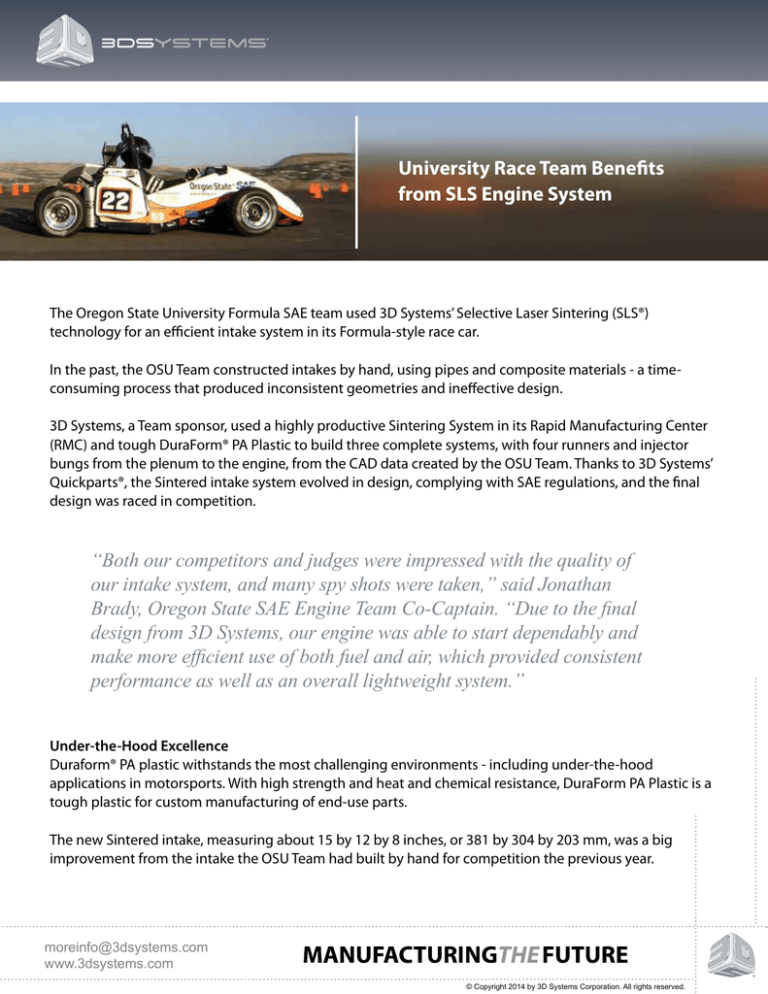
University Race Team Benefits
from SLS Engine System
The Oregon State University Formula SAE team used 3D Systems’ Selective Laser Sintering (SLS®)
technology for an efficient intake system in its Formula-style race car.
In the past, the OSU Team constructed intakes by hand, using pipes and composite materials - a timeconsuming process that produced inconsistent geometries and ineffective design.
3D Systems, a Team sponsor, used a highly productive Sintering System in its Rapid Manufacturing Center
(RMC) and tough DuraForm® PA Plastic to build three complete systems, with four runners and injector
bungs from the plenum to the engine, from the CAD data created by the OSU Team. Thanks to 3D Systems’
Quickparts®, the Sintered intake system evolved in design, complying with SAE regulations, and the final
design was raced in competition.
“Both our competitors and judges were impressed with the quality of
our intake system, and many spy shots were taken,” said Jonathan
Brady, Oregon State SAE Engine Team Co-Captain. “Due to the final
design from 3D Systems, our engine was able to start dependably and
make more efficient use of both fuel and air, which provided consistent
performance as well as an overall lightweight system.”
Under-the-Hood Excellence
Duraform® PA plastic withstands the most challenging environments - including under-the-hood
applications in motorsports. With high strength and heat and chemical resistance, DuraForm PA Plastic is a
tough plastic for custom manufacturing of end-use parts.
The new Sintered intake, measuring about 15 by 12 by 8 inches, or 381 by 304 by 203 mm, was a big
improvement from the intake the OSU Team had built by hand for competition the previous year.
moreinfo@3dsystems.com
www.3dsystems.com
© Copyright 2014 by 3D Systems Corporation. All rights reserved.
“Hand manufacturing entailed bending and welding small sections
of tubing for the s-curves, and a laborious process in composites for
the plenum,” Brady said. “Our team compared the two intakes backto-back and immediately noticed how easily the car started, and
the difference in both performance and fuel mileage.”
The Road to Competition
Before competition, the OSU team completed a full CAD model
of the race car, advanced engineering analysis and testing, part
manufacturing, vendor relations and finance.
At the Fontana Speedway in California where more than 80
universities from around the world were competing, the OSU Team
placed 10th in the Design category, 4th in both the Acceleration
and Skidpad categories (no other team did so well in both events),
and was on track to post the fastest lap times in Autocross and
Endurance when they suffered oil shaft and sensor failures. Even
with those failures, the Team placed 22nd.
The evolution of the team’s intake system
(above): The top photo is a 1.3 L plenum with
curved, tapered runners. Below that image
is a 1.5 L plenum with curved runners built
in a thicker material. Because of the curved
runner, the injector is aimed at the back of
the intake valve, allowing for more consistent
vaporization. On the car (right) is a 1.4 L
plenum with s-curve runners, allowing for a
box formation in the plenum.
OSU Formula Car Stats
0-60 mph in 3.4 seconds
81 hp at 12,000 rpm
92 mph top speed
1.4 g lateral acceleration
What is Formula SAE?
Formula SAE is a student design competition organized
by SAE International (formerly the Society of Automotive
Engineers). The first competition, originally called the Mini
Indy, was held in 1978.
The concept behind Formula SAE is that a fictional
manufacturing company has contracted a design team
to develop a small Formula-style racecar. The prototype
racecar is to be evaluated for its potential as a production
item. The target marketing group for the race car is the
nonprofessional weekend autocross racer. Each student
team designs, builds and tests a prototype based on a
series of rules whose purpose is both to ensure onsite
event operations and promote clever problem solving.
Currently, more than 200 universities around the world
conceive, design, fabricate and test their racecar, battling
head-to-head in a three-day multiple event competition.
moreinfo@3dsystems.com
www.3dsystems.com
© Copyright 2014 by 3D Systems Corporation. All rights reserved.
An Optimistic Prognosis
Dr. Rake is optimistic on the future of these techniques. “It’s true that using 3-D prototypes is rather expensive
now,” he says, “but costs are coming down and insurance companies are more willing to pay for these
procedures because they help reduce our operating room time, they help ensure a better outcome for the
patient, and they can help us avoid additional surgeries. I see this becoming more and more prevalent in
coming years as our profession and the patients experience the advantages.”
moreinfo@3dsystems.com
www.3dsystems.com
© Copyright 2014 by 3D Systems Corporation. All rights reserved.

